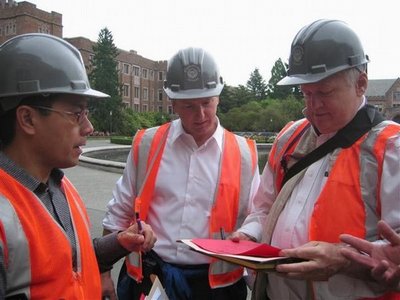March 11, 2010
A timely practice: Post-earthquake evaluation team to drill on campus March 25
There will be an earthquake in Seattle on Thursday, March 25. Not a real earthquake, of course, but a drill that will allow a campus team to discover how well prepared they would be if the earth did start shaking.
The drill is called the ATC 20, and involves a 20-minute post-earthquake evaluation of buildings to see if they are safe enough for people to re-enter. ATC stands for Applied Technology Council, the organization that established the procedures to follow in such a situation. ATC is a nonprofit corporation created to assist structural engineers to keep abreast of technological developments.
Tom Pittsford, a structural engineer who works for Campus Engineering — a part of Facilities Services — will be coordinating the drill, which is done annually. He’ll have five teams, each with about four members, who will be inspecting 10 buildings chosen for this drill. They are:
- South Campus Center
- Hitchcock Hall
- Fluke Hall
- Wilcox Hall
- Architecture Hall
- Kincaid Hall
- Mary Gates Hall
- Schmitz Hall
- Kane Hall
- MacKenzie Hall
Building occupants need not exit during the drill, but they will be seeing team members around wearing hard hats and safety vests and carrying radios. Each team is equipped with a pre-packed backpack containing caution tape, posting placards, an ATC field manual, flashlights, gloves, masks, safety glasses, ATC 20 forms, clipboards and writing implements, copies of placards and evaluation forms, a campus map and a UW building inventory with priority lists.
Once at their assigned buildings, the teams will inspect them, looking specifically for six things:
- Has the building collapsed, partially collapsed or moved off its foundation?
- Is the building or one story of it noticeably leaning?
- Has the wall moved horizontally so that its top is not square with its base? Is there obvious severe damage and distress?
- Are bricks or masonry falling or likely to fall from a parapet, chimney or other feature?
- Is there severe ground or slope movement?
- Are there other hazards such as gas leaks, power lines down etc.?
The team will not actually see any such damage, but for the purpose of the drill, photos of the buildings have been produced that simulate problems. The job of the team is to decide how to post the buildings, based on what they see in the photos. Red placards indicate that it is unsafe for anyone, yellow ones designate restricted access, while green placards mean the building is safe for everyone. The team also has yellow tape that can be used to mark unsafe outdoor areas, such as an area that would be affected by falling bricks.
“The main goal of an ATC 20 evaluation in a real earthquake is to not let any student, faculty or staff member into a damaged building,” Pittsford said. “The second goal is to facilitate the business continuity plan of the University — to get it back up and running as soon as possible.”
To that end, all the buildings on campus have been prioritized as to which ones would be evaluated first after an earthquake. Because this isn’t a medical response, the most damaged buildings would not necessarily be the first ones to be evaluated. Rather, it is those most critical to the ongoing operation of the institution.
Although ATC requires that a structural engineer or an architect lead inspection teams, Pittsford said anyone can be trained to participate, since most of what is being looked for is obvious damage. And with more than 250 buildings on the UW Seattle campus, many trained people would be needed after a real earthquake. About 40 active employees have had the training.
The purpose of the drill is to allow team members to brush up on their skills and to find any holes in the system. “We’re set up to be self starting,” Pittsford said. “If there was an earthquake right now, we’d be out there in 10 minutes, starting our work. If it’s off hours, team members are supposed to call their manager to see who’s coming in. Everyone needs to be familiar with the procedures so they can get the work done efficiently.”
The last time they had a drill, one team accidentally overlooked filling out the evaluation forms that get returned to the office. These forms would likely need to be sent to the Federal Emergency Management Agency. That lapse led Pittsford to realize he needed to do refresher training more often.
“That’s why we do the drills, to find out what the problems are so we can correct them,” Pittsford said.
The March 25 drill is scheduled to begin as soon as team members arrive for work and should be completed by 9:30 a.m.



